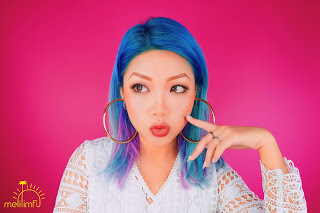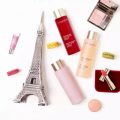Is working with influencers on social media a good solution to gain market share in China? “In China, KOL (Key Opinion Leaders) marketing can represent over 30% of marketing resources for global/mature brands, and 80% of marketing resources for independent brands newer to the Chinese market,” asserts Kim Leitzes, founder of ParkLU, a platform designed to act as an intermediate between brands and Chinese influencers. She presented her business at the last China Connect show, the annual event for Internet players in China held in early March in Paris.
Among the speakers at the conference, which focused on the theme “Crack the Codes”, there was Melilim Fu (real name傅沛 Fu Pei), a Chinese KOL who came from Beijing with her American boyfriend and associate, Elijah Whaley, who is specialized in marketing content, and with whom she created her makeup video platform.
Differentiating niche
Since August 2015, Melilim Fu has posted about thirty makeup tutorials and a thousand pictures, and offered twelve live streaming sessions. With her blue or pink-dyed hair, coloured lenses, and strong makeup, Melilim Fu chose to stand out in a world of beauty videos dominated by light-skinned Koreans, and where Chinese women are still scarce, to her. “I am a makeup artist, and even if I may draw inspiration from the Western world and Japan, my top priority is to help and guide Chinese women discovering makeup, and make them feel self-confident,” Melilim Fu explains. If, when she started, her videos could shock Chinese web users more keen on lightness and discretion, they are now widely accepted by a fast-changing clientele. Contacts with her public are crucial, she emphasizes. “I answer all questions, and our exchanges can get very personal. My generation – I was born in 1991 – is made of people who grew up in one-child families and are eager for interactions.”
On Weibo, the Chinese Twitter, Melilim Fu currently counts almost 175,000 fans. “From the beginning, we decided to use Weibo for Melilim’s content hub. This choice was a bit of a gamble, but it was a well-placed bet, as Weibo continues to gain popularity and WeChat [the most widely used mobile messaging service in China, which features many applications], remains a harsh environment for UGC [1] video distribution,” explains Elijah Whaley, who also highlights that “China’s online video ecosystem differs from the rest of the world’s, which relies heavily on Google and YouTube.” According to him, not a single video platform in China comes close to matching YouTube’s popularity or sophisticated search algorithms – LeTV, one of China’s most popular video sites, does not even accept UGC videos. Melilim Fu does use WeChat, although she has no official account, as well as Instagram and Snapchat, “to experience the playfulness of filters, without particularly trying to reach a Western public, but rather Chinese people abroad.”
Different approach, same target
Melilim Fu states she has worked with “global brands like H&M, Nike, and Make Up For Ever, as well as with many small brands,” but few Chinese brands. “It seems consumers’ trust in Chinese products is a real issue,” she thinks. Elijah Whaley adds that “even if we have not achieved that yet, exclusive contracts with brands are the best way for them to capitalize on a KOL,” referring to the exclusive collaborations with global brands signed by Chinese Internet stars – whose number of fans exceeds 800,000 on Weibo – like that between humourist Papi Jiang and Shanghai-based cosmetics online retailer Lili&Beauty, or actress and singer Angelababy and Maybelline, of the L’Oréal group.
The duo declares they usually work for a flat rate. “In addition, we have recently had the opportunity to try out our e-commerce skills. Someone who sells foreign products through WeChat and Weibo offered to redirect our traffic towards these two accounts. In only seven days, we made US$25,000 sales, of which we perceived 20%,” Elijah Whaley explains. To him, this type of collaboration can only work with brands with limited distribution channels.
Live streaming is booming
“Other collaborations mainly help us gain attention and reach more people,” Elijah Whaley continues. “With Yes, a brand that developed a live streaming to e-commerce application, we made a one-hour live video in a shopping mall that sold the brand’s products, generating a US$5,000 sales volume.” The experience, which allowed web users to react, was very positive, according to Melilim Fu. “People told me they had the impression they went shopping with me.”
These live videos are on a roll: the trend spread across China last year, so much that Maybelline organized a giant live streaming event in Shanghai with many KOLs to launch a lipstick. It is believed that China counts 344 million live broadcast users, i.e. almost half the number of web users. Two thirds of them are men, and most are under 30, according to the iResearch institute quoted by French newspaper Les Échos. The number of platforms has literally boomed over the past two years, and it is said there are almost 200 of them today.
“Just like China’s TV offering, most of the content of these videos is devoid of any interest, so we have the opportunity to catch people’s attention by producing quality, both live and in our recorded videos,” Elijah Whaley underlines. To him, a well-performing KOL “can guide a given social media platform public towards a shopping environment.” Kim Leitzes (ParkLU) shares this vision, so she recommends brands to invest time with their KOL and set up a content strategy.
This feature was commissionned and published by Premium Beauty News





